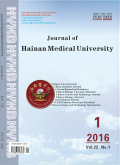- 钛学术文献服务平台 \
- 学术期刊 \
- 医药卫生期刊 \
- 大学学报期刊 \
- 海南医科大学学报(英文版)期刊 \
The mechanism of Wumei Wan on treating diabetes enteropathy based on the network pharmacology
The mechanism of Wumei Wan on treating diabetes enteropathy based on the network pharmacology
基本信息来源于合作网站,原文需代理用户跳转至来源网站获取
摘要:
Objective: To explore the potential mechanism of Wumei Wan(WMW) in treating diabetes enteropathy(DE) basing on network pharmacology. Methods: The effective compound of WMW were collected by TCMSP, the potential target of WMW was obtained by means of PubChem and Swiss target prediction online tools, and the disease target of DE was obtained by Genecards, TTD and DisGeNET databases, Cytoscape 3.7.2 software was used to construct active ingredients of WMW-potential target-DE network, protein interaction network(PPI) was constructed by STRING database. In order to understanding the mechanism of WMW treating in DE, Omicshare platform was used for GO analysis and KEGG pathway enrichment analysis. The analysis results were verified through docking by Discovery Studio 2016. Results: Total of 128 active components and 139 targets of WMW were screened out from the ten drugs. A total of 714 disease targets were screened out from the disease databases.24 common targets were identified from both WMW and DE.AKT1, MMP9, SRC, PTGS2, PPARG, NOS2, etc. are potential major targets of WMW in the treatment of DE.61 entries (p<0.05) were enriched in GO biological process function related to fatty acid anabolism and ligand receptor binding, as unsaturated fatty acid metabolic process, icosanoid metabolic process,enzyme linked receptor protein signaling pathway,protein amino acid phosphorylation,cellular response to insulin stimulus. A total of 72 signaling pathways were obtained through KEGG pathway analysis (p<0.05). The signaling pathways closely related to DE are including relaxin signaling pathway, EGFR tyrosine kinase inhibitor resistance, CLRs signaling pathway, and VEGF signaling pathway. Conclusion: This study preliminarily revealed the material basis and mechanism of WMW in the treatment of DE from the synergistic aspects of intestinal immune balance, gastrointestinal wall structure reconstruction, intestinal microvascular disorder and neuronal activity.

推荐文章
Mechanism of accelerated dissolution of mineral crystals by cavitation erosion
Cavitation erosion
Mineral dissolution
Plastic deformation
Stepwave
Gibbs free energy
SD-WAN在物联网应用探索
物联网
SD-WAN
自动化
专线配置
平台
SD-WAN三种技术方案的研究
SD-WAN
云计算架构模式
云计算结合骨干网架构模式
内容分析
关键词云
关键词热度
相关文献总数
(/次)
(/年)
文献信息
| 篇名 | The mechanism of Wumei Wan on treating diabetes enteropathy based on the network pharmacology | ||
| 来源期刊 | 海南医科大学学报(英文版) | 学科 | |
| 关键词 | |||
| 年,卷(期) | 2021,(7) | 所属期刊栏目 | Original article |
| 研究方向 | 页码范围 | 27-35 | |
| 页数 | 9页 | 分类号 | |
| 字数 | 语种 | 英文 | |
| DOI | |||
五维指标
引文网络
引文网络
二级参考文献 (7)
共引文献 (1)
参考文献 (27)
节点文献
引证文献 (0)
同被引文献 (0)
二级引证文献 (0)
2001(1)
- 参考文献(1)
- 二级参考文献(0)
2006(1)
- 参考文献(1)
- 二级参考文献(0)
2007(1)
- 参考文献(1)
- 二级参考文献(0)
2011(1)
- 参考文献(1)
- 二级参考文献(0)
2012(1)
- 参考文献(1)
- 二级参考文献(0)
2014(2)
- 参考文献(2)
- 二级参考文献(0)
2015(2)
- 参考文献(2)
- 二级参考文献(0)
2016(6)
- 参考文献(4)
- 二级参考文献(2)
2017(3)
- 参考文献(2)
- 二级参考文献(1)
2018(8)
- 参考文献(4)
- 二级参考文献(4)
2019(7)
- 参考文献(7)
- 二级参考文献(0)
2020(1)
- 参考文献(1)
- 二级参考文献(0)
2021(0)
- 参考文献(0)
- 二级参考文献(0)
- 引证文献(0)
- 二级引证文献(0)
引文网络交叉学科
相关学者/机构
期刊影响力
海南医科大学学报(英文版)
主办单位:
海南医学院杂志社
出版周期:
半月刊
ISSN:
1007-1237
CN:
开本:
出版地:
海南省海口市学院路3号
邮发代号:
创刊时间:
语种:
eng
出版文献量(篇)
3478
总下载数(次)
0
总被引数(次)
315
期刊文献
相关文献
推荐文献
- 期刊分类
- 期刊(年)
- 期刊(期)
- 期刊推荐
海南医科大学学报(英文版)2022
海南医科大学学报(英文版)2021
海南医科大学学报(英文版)2020
海南医科大学学报(英文版)2019
海南医科大学学报(英文版)2018
海南医科大学学报(英文版)2017
海南医科大学学报(英文版)2016
海南医科大学学报(英文版)2015
海南医科大学学报(英文版)2021年第9期
海南医科大学学报(英文版)2021年第8期
海南医科大学学报(英文版)2021年第7期
海南医科大学学报(英文版)2021年第6期
海南医科大学学报(英文版)2021年第5期
海南医科大学学报(英文版)2021年第4期
海南医科大学学报(英文版)2021年第3期
海南医科大学学报(英文版)2021年第24期
海南医科大学学报(英文版)2021年第23期
海南医科大学学报(英文版)2021年第22期
海南医科大学学报(英文版)2021年第2期
海南医科大学学报(英文版)2021年第17期
海南医科大学学报(英文版)2021年第16期
海南医科大学学报(英文版)2021年第15期
海南医科大学学报(英文版)2021年第14期
海南医科大学学报(英文版)2021年第13期
海南医科大学学报(英文版)2021年第12期
海南医科大学学报(英文版)2021年第11期
海南医科大学学报(英文版)2021年第10期
海南医科大学学报(英文版)2021年第1期

 免费查重
免费查重










